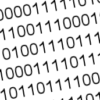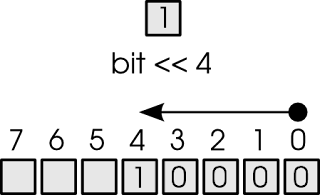After an introduction of the Hit-or-miss operator [Link], it is time to see how we can implement this kind of tool in ImageJ with JavaScript....
1- Do It Yourself
The synopsis of the implementation written in pseudo-code is as follows ...output = create_new_image();
for each pixel of the input image
values = get_pixel_values_of_8_neighbors(pixel)
new_pix = hit_or_miss(values)
output.setPixel(new_pix)
end for
1-1- Implementing the convolution
The first step is to get the neighboring pixel values for each pixel values (Fig. 1). |
| Fig.1: Coordinates of the eight neighbors of central pixel (X,Y). |
Second, we need to compare the pixel values to the pattern of the structuring element.
A naive implementation would consist of (i) putting the values in an array and (ii) comparing them to the kernel numbers in a huge 'if' something like ...
if (array[0]==kernel[0] && array[1]==kernel [1] && .... ) {
// do erosion
}
1-1-1 Encoding neighbors and the structuring element
It is better to encode the eight values in a number of 8 bits (= 1 byte) and then to compare the two 8-bits numbers in a simple 'if'.
For this purpose, I choose − because it will be convenient to calculate the rotated kernels (see below) − to store the neighbors from the top left corner and successively in clockwise order as shown in Fig. 2.
| 1 2 3 8 * 4 7 6 5 |
| Fig. 2: Numbering of neighbors. |
A structuring element (Fig. 3) is converted as the binary number 10100101 according to Fig. 2 and is transformed in decimal with the parseInt(..) JavaScript function yielding - here - 245.
 |
| Fig.3: Formatting and encoding of the structuring element in a decimal number. |
(ii) Encoding 8 neighboring pixel values
There is an additional step because we need to convert the 0 and 255 (the only available pixel values in a binary image) in a series of 0 and 1 before packing them in a 8-bit number.
This is done with a 'if' statement as follows...
if (pixel == 255) {
bit=1
}
else {
bit=0;
}
but there is a more concise way like ...bit = (pixel ==255) ? 1: 0;
... and you can go further by simplifying ...
bit = (pixel == 255);
Note: In this case, the condition (pixel == 255) returns TRUE, however, TRUE is mapped as a 1 and can be used as a digit. FALSE is equal to 0.
Now, I can build a string with the collection of 0 and 1 and use the parseInt(...) function as described previously with the structuring element. But, here this is a good opportunity to play with the bitwise operators.
In all the programming languages, there are special operations occurring at bit level. They are the shift ( << or >>) and logical (& or | ) operators.
The shift operator allows to move to the left (<<) or to the right (>>), bit(s) into a byte as shown in Fig. 4.
Then, to stack the 8 bits, we have to OR them with the '|' operator
byte = bit7 | bit6 | bit5 | bit4 | bit3 | bit2 | bit1 | bit0
Finally, all the various parts can be merged into a single expression and the code becomes ...
var v = (ip.getPixel(x-1,y-1)== FOREGRND) << 7 | (ip.getPixel(x ,y-1)== FOREGRND) << 6 | (ip.getPixel(x+1,y-1)== FOREGRND) << 5 | (ip.getPixel(x+1,y )== FOREGRND) << 4 | (ip.getPixel(x+1,y+1)== FOREGRND) << 3 | (ip.getPixel(x ,y+1)== FOREGRND) << 2 | (ip.getPixel(x-1,y+1)== FOREGRND) << 1 | (ip.getPixel(x-1,y )== FOREGRND);
Note: FOREGRND is a constant corresponding to the foreground pixel value (0 or 255).
1-2- What about the 'Don't Care' pixels ?
Actually, we need a mask for removing the unrequired pixels.X 1 X
0 1 1
0 0 X
X1X1X000 If you use a mask setting a '0' to remove the 'Don't care' pixels and a '1' for the others. In this example, the mask is equal to 01010111
X1X1X000
01010111 <- mask
Ex:
11011000
01010111
01010000
1-3- Calculating the rotated structuring elements
A 45° rotation is simply a circular permutation as shown in Fig. 2 and a 90° rotation two successive permutations.| 12345678 → 81234567 |
| Fig. 2: Numbering of neighbors after a rotation of 45°. The rotation corresponds to a circular shift of 1 digit to the right. |
2- Script
In the script, the kernel is defined by:- its type (S, R4, and R8)
- its value stored as a string composed of 0, 1, and X characters.
They are pre-loaded and built in the function loadStructElements(...).
The main loop scans the whole image, get the local neighbors, convert the pixels in a byte for the comparison, and then update the output image if there is an exact match.
+++ JavaScript IJ snippet: hit-or-miss.js +++
+++ End of JavaScript IJ snippet +++
This is the end of this small series dedicated to Hit-or-Miss operator. Thank you for reading these lines, and feel free to check out the code and share your comments below.
Further reading
Mathematical morphology [Link]Image Processing [Link]



No comments:
Post a Comment